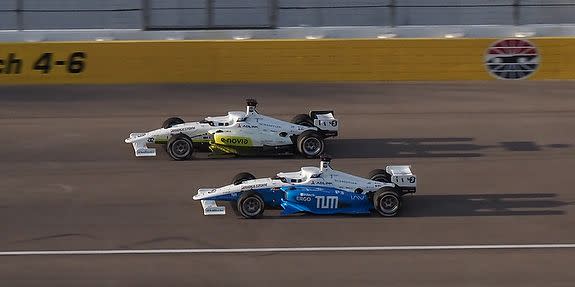How Indy Autonomous Racing Got Real at Las Vegas Motor Speedway

Officially this was the second round of the Indy Autonomous Challenge (IAC).
The first round held last October at the Indianapolis Motor Speedway was only time trials, while Friday's event at Las Vegas featured two cars at a time in head-to-head racing.
Once the cars were lapping at over 150 mph it was not that dissimilar from cheering for two “normal” race cars running neck and neck to the checkered flag.
“Ladies and gentlemen, start your software.” And with those history-making words, uttered by Karen Chupka, EVP of CES, Consumer Technology Association, the world’s first ever race for autonomous race cars got booted up at the Las Vegas Motor Speedway.
Officially this was the second round of the Indy Autonomous Challenge (IAC) but as it turned out the first “race” held last October at the Indianapolis Motor Speedway was only time trials where nine autonomous race cars drove one-at-a-time around the famous oval.
This time the organizers created a head-to-head elimination race with two cars on the track at a time—somewhat similar to how drag races are conducted.
“The software algorithms required to make two cars race side by side at up to 170 mph takes a considerable jump in resources compared to a solo run,” said Paul Mitchell, president and CEO of Energy Systems Network, the company that produces the IAC, before the racing action got under way on Jan. 7.

Halo, a driverless Kia remotely controlled by an engineer sitting in front of a monitor in the media room, served as the official pace car, leading each of the teams from pit lane so they could complete warmup laps at speeds of 65-80 mph before the start of each round. The Kia’s engineer/pilot communicated with the modified car using T-Mobile’s 5G network.
All of the autonomous race cars are based on a modified Indy Lights racer built by Dallara and powered by a 2.0-liter, turbocharged 388 bhp Honda (K20C) engine. Each cockpit is filled with identical electronic guts including three Lidars, three Radars, six cameras, computers and sensors. Co-incidentally the weight of all this electronics closely matches the weight of a human driver, which meant Dallara did not need to do much suspension re-engineering.
The race cars were programmed to run laps at increasingly faster speeds. On each lap the car in front was the defender and it was up to the second car, the attacker, to safely pass the defender. If it succeeded it then became the defender and the other was designated as the attacker. Passes could only be made along the front straight.
It sounds boring, but in actuality the final race, which pitted the two cars (PoliDRIVE and TUM) that had also proven themselves as being the fastest at Indy, was far from boring.

 Yahoo Autos
Yahoo Autos 